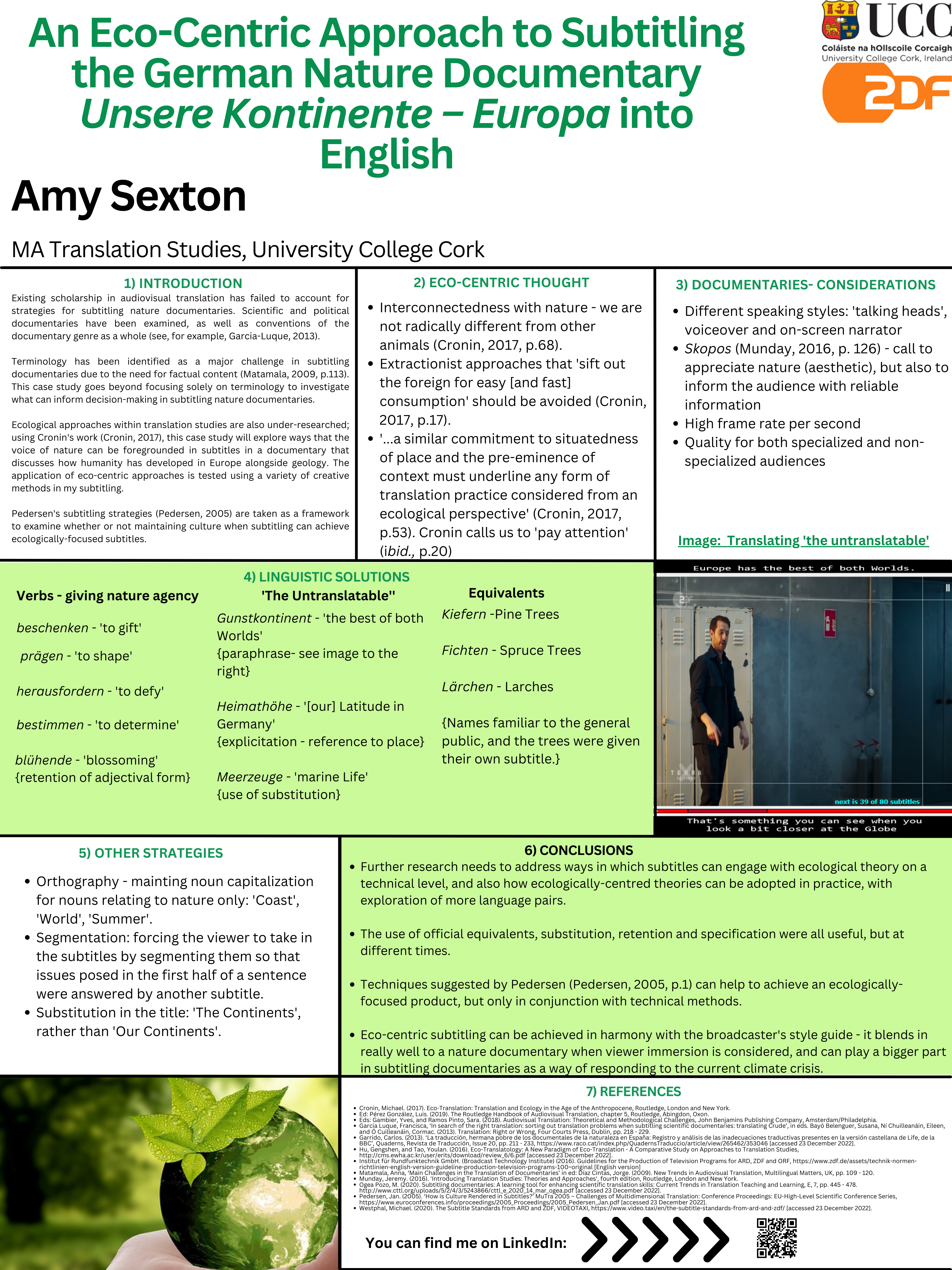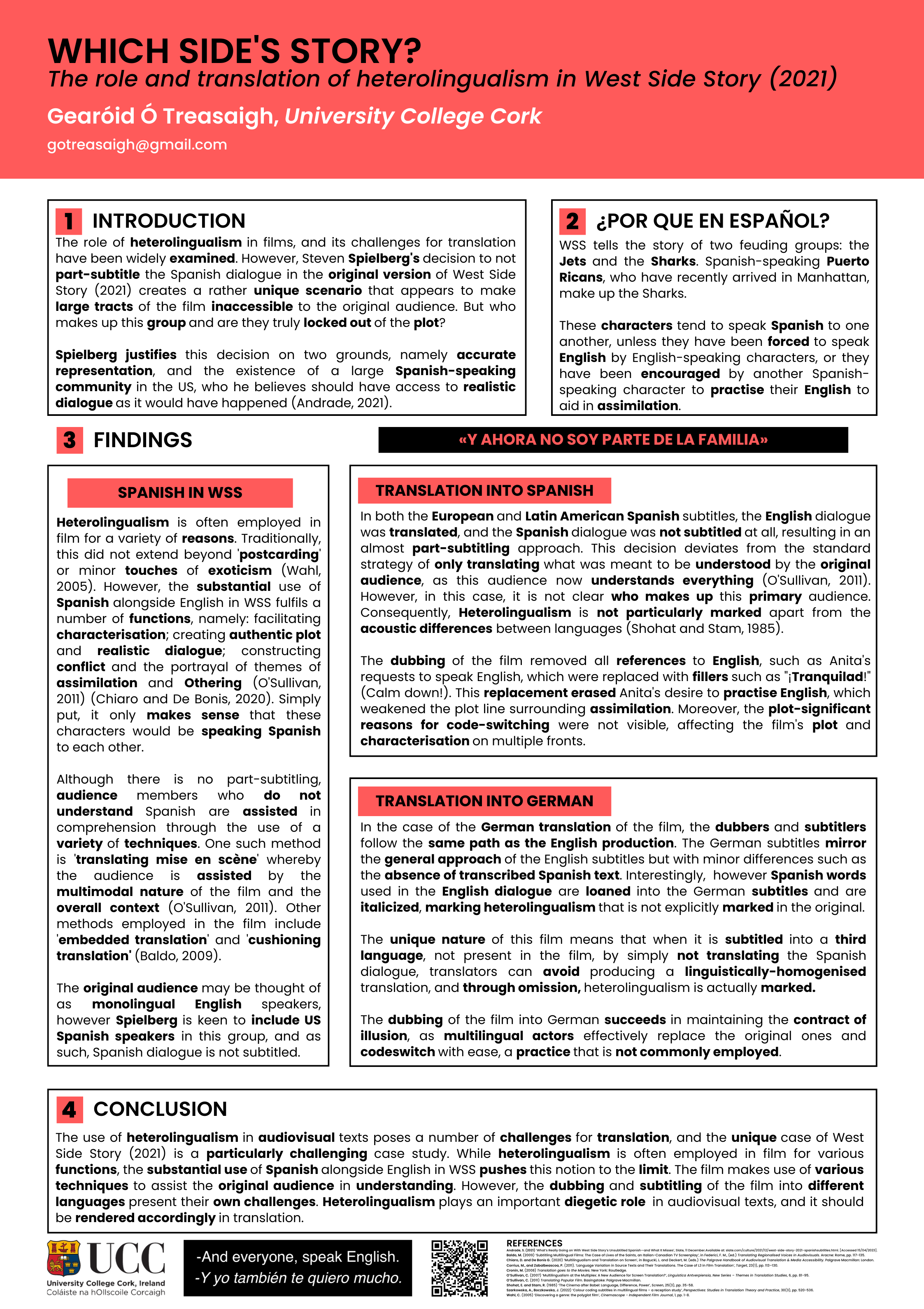In late April, as the teaching semester wound up, University College Cork hosted the 3rd annual conference of the Translation Studies Network of Ireland, on the theme of Radical Translation(s)/Translating the Radical. Hannah shared SubComm and the work we have been doing in a presentation that was well-received by academics and translators in attendance. Two current MA in Translation Studies students – Gearóid Ó Treasaigh and our own Amy Sexton – presented posters on their work in the area of subtitling, and we thought it would be interesting to share their work with the SubComm community.
An Eco-Centric Approach to Subtitling the German Nature Documentary
Unsere Kontinente – Europa into English

Amy Sexton is a student of the MA in Translation Studies at University College Cork. She translates between German and English and Spanish and English, and she also holds a BA (Joint Honours) in European Studies with German and Spanish from UCC. Amy’s passion for audio-visual translation developed within her role as research assistant for SubComm, and has led her to present her own case study in the field as part of the assessment for her MA audio-visual translation module.
![]() @AmySexton776
@AmySexton776

As a field of study, ecological approaches to translation are gaining attention but have not yet been vigorously applied to the audio-visual context. I wanted to create a practical example of how eco-centric thought can inform subtitles for a nature documentary, taking into account the unique challenges posed by documentary subtitling. Additionally, I wanted to go beyond purely discussing terminology, as much of the scholarship on subtitling documentaries addresses terminological issues. Putting the voice of nature at the centre of the subtitles proved to be a multi-faceted task that went beyond linguistic considerations.
Using Pedersen’s strategies for rendering culture in subtitles (Pedersen, 2005), I assessed what strategies worked best for solving different challenges in the subtitles. I expected more source text-oriented strategies to be more useful, as ecological thought discussed by Cronin (Cronin, 2017) calls for translations not to completely remove foreign elements of the source text. I was able to keep characteristics of German through maintaining the capitalisation of nouns, an interventionist strategy (but one which did not affect character limits) that also gave primacy to natural forces in the subtitles. However, more target text-oriented strategies were necessary for naming species of trees and explaining German compound nouns.
Although I was dealing with different speaking styles, the high frame rate (150fps) and long shots allowed me scope to segment longer sentences in ways that I felt gave nature a voice in the text and forced the viewer to ‘pay attention’ (Cronin, 2017). In one instance, I was able to give three species of trees their own subtitle. The long shots also allowed me to retain most of what the narrators were saying, (a luxury not afforded to films with a lot of dialogue) although I omitted phatic language.
I was delighted by the attention my poster got at the TSNI conference, and I hope that my suggestions will create interest in further research and case studies in this line of audio-visual translation. I’m happy to discuss the poster and my solutions further with anyone who wants to know more.
WHICH SIDE’S STORY?
The role and translation of heterolingualism in West Side Story (2021)

Gearóid Ó Treasaigh hails from East Galway in the West of Ireland, but has been a student in UCC for the last five years having completed a BA in World Languages and working towards an MA in Translation Studies. Gearóid is interested in heterolingualism in translation, and his MA dissertation will focus on the translation of heterolingual elements in two films, West Side Story (2021) and In The Heights (2021). Aside from his studies, Gearóid works as a freelance proofreader, writer and Irish-language teacher.
![]() @gotreasaigh
@gotreasaigh

As part of the poster session of the TSNI’s 3rd Annual Conference, I was delighted to put forward a poster based on some of the initial research that I have undertaken for my MA dissertation. This poster focused on the heterolingual or multilingual elements of the 2021 remake of West Side Story. What makes this film a particularly interesting case study is the filmmaker’s decision to not part-subtitle the original version of the film, that is to say that where there is Spanish dialogue in the original version of the film, this is not subtitled for the film’s primary audience. Many would assume that this audience consists of monolingual English speakers in the US who would not understand Spanish dialogue without some kind of assistance. The filmmaker, however, puts forward that the US is home to a large Spanish-speaking population and given the content of the film, it is important to respectfully represent this community, and to allow this community’s story to be told in their own language. By not translating this dialogue for the English-speaking audience, it is as if Spielberg is reversing the early policies in Hollywood whereby every community’s story was told through the voice of the English-speaker. This film tells the story of Spanish-speaking Puerto Rican migrants in the US, and my poster explored the reasons for representing multilingualism in the film; how this multilingualism was designed to be understood by the film’s primary audience (monolingually English or otherwise), as well as how the film was subtitled and dubbed into German and Spanish. It was so wonderful to be able to share my research with some excellent scholars and I was delighted to receive so much useful feedback and suggestions!
